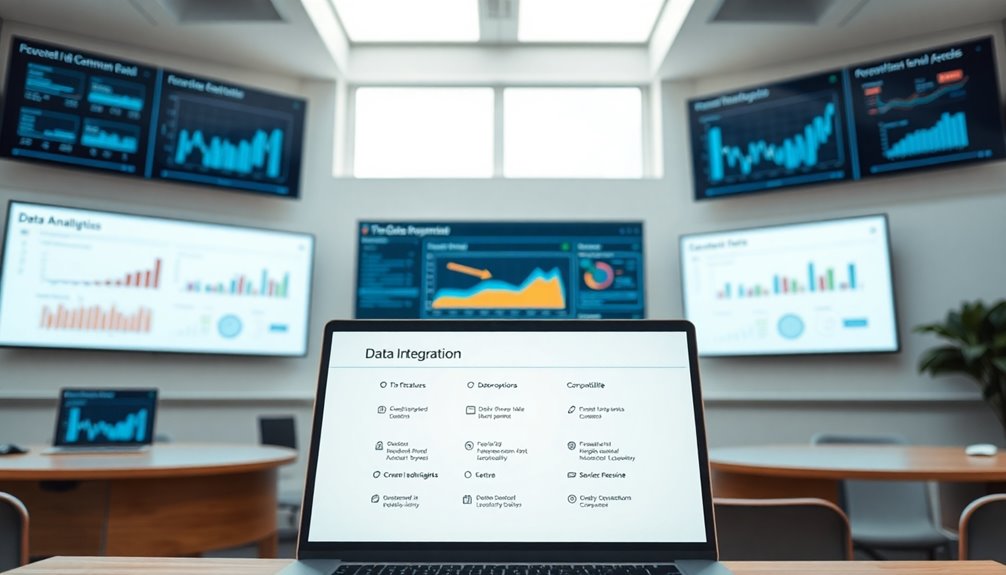To build a single source of truth in schools, start by identifying key data sources like student information and operational metrics. Use data integration tools that offer customization and compatibility. Craft data governance policies to manage data ownership and security. Design a unified data architecture to guarantee seamless data flow and consistency. Finally, implement automated data collection and facilitate real-time access for stakeholders. Discover extensive strategies for effective data integration and optimization.
Highlights
- Implement a unified data architecture to seamlessly integrate existing school data sources for a comprehensive single source of truth.
- Utilize data integration tools with strong customization capabilities to ensure compatibility and future scalability within the school's data ecosystem.
- Standardize data formats and schemas across different systems to maintain consistency and facilitate efficient data integration processes.
- Employ advanced data validation and cleaning techniques to ensure data accuracy and eliminate discrepancies across integrated sources.
- Design real-time dashboards with secure access for stakeholders to enhance decision-making and foster transparency within the school community.
Understanding the Importance of a Single Source of Truth

In today's data-driven educational landscape, having a single source of truth is essential for schools aiming for accuracy and consistency. You understand that data accuracy is critical for effective decision making.
When everyone in your school community—teachers, administrators, and parents—engages with reliable data, it fuels stakeholder engagement and strengthens your collaborative culture.
Technology adoption plays a pivotal role in this transformation, empowering you to streamline processes and enhance data literacy among staff. This shift isn't just about technology; it's about embracing continuous improvement and implementing change management to foster an environment where innovation thrives. Additionally, leveraging data-driven decision-making can significantly enhance your school's operational efficiency and overall effectiveness.
Identifying Key Data Sources in Schools
Where do you start when pinpointing key data sources in schools?
Begin by identifying vital data points that fuel innovation and streamline operations. Consider these foundational elements:
1. Student Information: Explore student performance, attendance records, assessment results, and behavioral incidents.
They're pivotal for tracking progress and personalizing education.
2. Operational Metrics: Look at enrollment statistics, course schedules, and demographic information.
These insights help in planning and adapting to changing educational landscapes.
3. Resource Management: Examine financial data, staff qualifications, and resource allocation.
This data is essential for optimizing budgets and ensuring high-quality education delivery. Additionally, integrating advanced analytics can enhance understanding of learner behavior and improve overall performance.
Selecting the Right Data Integration Tools

When selecting data integration tools for schools, you need to evaluate various software options to find the best fit. Make sure to assess each tool's compatibility with your existing systems and its ability to scale as your needs grow. Choosing the right solution can streamline processes and enhance data management efficiency. Additionally, leveraging data-driven decision making can empower educators to implement informed strategies that improve student outcomes.
Evaluating Integration Software Options
How do you go about selecting the right data integration tools for your school? With innovation as your guide, you'll want to guarantee you're making choices that align with dynamic educational needs.
Begin with these steps:
- Evaluate Software Features: Delve into the capabilities, exploring customization possibilities and integration capabilities. Are they robust enough for your school's unique requirements?
- Compare Pricing Models: Analyze costs against budget constraints while considering long-term value. Are there flexible pricing options?
- Assess User Experiences: Review support options, analyze case studies, and evaluate interoperability standards. How do current users rate ease of deployment, and what's the vendor reputation?
Assessing Compatibility and Scalability
After evaluating software features, pricing models, and user experiences, the next step focuses on compatibility and scalability in selecting the right data integration tools for your school.
Embrace innovation by prioritizing software compatibility and system interoperability to minimize integration challenges. Guarantee that your tools align with current data standards and are adaptable to future scalability needs.
As technology trends evolve, you'll want a solution that simplifies data migration and enhances user experience. Don't overlook cost considerations, but also weigh the importance of robust vendor support to navigate unforeseen issues.
A forward-thinking approach guarantees your data integration solution not only meets today's needs but is also primed for tomorrow's demands, seamlessly transforming your school's data landscape.
Establishing Data Governance Policies
When you're setting up data governance policies in schools, it's essential to clearly define who owns the data, so responsibilities are transparent. You'll want to standardize data formats to guarantee consistency and ease of integration across systems. Don't forget to prioritize data security, safeguarding sensitive information from potential breaches. Additionally, implementing data-driven growth strategies can help schools optimize their operational performance and enhance decision-making processes.
Defining Data Ownership
To effectively manage the vast amounts of data in schools, establishing clear data governance policies is vital. You need to define data ownership to guarantee efficient data stewardship and accountability. Assigning specific ownership roles helps maintain clarity and responsibility.
Here's how you can approach it:
- Identify Ownership Roles: Determine who's responsible for each data set. This could include administrators, teachers, or IT staff. Clear roles prevent confusion and guarantee accountability.
- Establish Data Stewardship Guidelines: Develop protocols for how data should be managed, updated, and accessed. This creates a culture of responsibility and enhances data integrity.
- Implement Training Programs: Educate staff on their ownership roles and the importance of data governance. Training fosters innovation and empowers everyone to contribute effectively to the school's data ecosystem.
Embrace these strategies to build a robust data governance framework.
Standardizing Data Formats
A crucial step in establishing data governance policies is standardizing data formats across all systems and platforms. You need to guarantee data format standardization to eliminate discrepancies and foster seamless integration.
Aligning your data schema across various systems isn't just a technical task—it's a transformative strategy that paves the way for innovative educational solutions. By creating a unified structure, you'll empower your school to make data-driven decisions without the noise of incompatible data formats.
School administrators, teachers, and students can then access accurate information swiftly, leading to more insightful analyses and improved learning outcomes. Embrace data schema alignment as a key driver of change, allowing your institution to harness the full potential of its data ecosystem.
Ensuring Data Security
While aligning data schema creates a unified structure for seamless integration, protecting this valuable data is equally important.
Establishing robust data governance policies guarantees your school's information remains secure and compliant. Here's how you can innovate in data security:
1. Implement Advanced Security Measures****: Use data encryption, access controls, and user authentication to safeguard data.
Regular risk assessments and breach detection can prevent unauthorized access.
2. Adhere to Compliance Regulations**: Confirm your data practices** align with legal standards.
This includes data anonymization and regular security training for staff, keeping everyone informed and prepared.
3. Prepare for the Unexpected: Develop a solid incident response plan and maintain regular data backups.
These steps minimize data loss and assure quick recovery during unforeseen events.
Designing a Unified Data Architecture
When starting on the journey of designing a unified data architecture for schools, it's vital to focus on creating a system that seamlessly integrates existing data sources while remaining scalable for future needs.
Begin with a robust data model that guides your architecture design. Leverage integration frameworks to manage data flow efficiently. Schema standardization is important for system interoperability, guaranteeing smooth communication between systems.
Start with a robust data model and standardize schemas for seamless system interoperability.
Metadata management enhances clarity and organization. Embrace API utilization to connect disparate systems and consider cloud solutions for flexibility.
Employ data lakes and data warehouses to store vast amounts of information securely. Prioritize performance optimization to keep the system running smoothly. This approach guarantees a dynamic, innovative foundation for educational data management, paving the way for a more informed academic environment. Furthermore, implementing automation solutions can significantly enhance operational efficiency across educational institutions.
Implementing Automated Data Collection Processes

Implementing automated data collection processes opens up a world of efficiency and accuracy in educational data management.
You'll streamline operations by reducing manual entry errors and ensuring real-time access to critical information. By integrating sophisticated data collection strategies, schools can revolutionize how they gather and utilize information.
Consider these innovative steps:
- Leverage automated feedback systems to instantly capture student performance metrics, providing teachers with actionable insights for personalized instruction.
- Utilize smart sensors and IoT devices for real-time data acquisition in classrooms, enabling a dynamic learning environment that adapts to student needs.
- Adopt cloud-based platforms to centralize data, ensuring seamless accessibility and collaboration among educators, administrators, and stakeholders. Additionally, implementing optimized strategies can further enhance the effectiveness of these data collection processes.
Ensuring Data Quality and Consistency
To maintain the integrity of educational data, ensuring data quality and consistency is paramount. You need to employ innovative data validation techniques to automatically identify errors and inconsistencies before they disrupt your insight-driven decisions.
By using advanced algorithms, you can streamline the process of verifying data accuracy, making your educational environment more efficient and reliable.
Streamline data accuracy with advanced algorithms for a more efficient and reliable educational environment.
Additionally, adopting robust data cleaning methods is essential. These methods help you eliminate duplicates, correct errors, and standardize information across multiple data sources, ensuring that the data you rely on is both accurate and actionable.
With these strategies, you'll empower your educational institution to build a trustworthy data ecosystem, driving innovative decision-making and maximizing the potential of your integrated data resources. Implementing revenue management tools can further enhance your ability to analyze and utilize data effectively.
Consistency and quality are your keys to success.
Facilitating Real-Time Data Access for Stakeholders
Although guaranteeing data quality is essential, facilitating real-time data access for stakeholders is equally important in educational settings.
By integrating real-time dashboards, you empower teachers, administrators, and parents to make informed decisions swiftly. Embracing collaborative data sharing not only streamlines communication but also enhances transparency and accountability. This approach mirrors the data-driven strategies employed in the hospitality industry to optimize guest experiences.
Here are three key elements to take into account for effective real-time data access:
- User-Friendly Dashboards: Design intuitive interfaces that stakeholders can easily navigate, offering clear insights at a glance.
- Secure Access Protocols: Implement robust security measures to protect sensitive information while allowing seamless access to authorized users.
- Scalable Infrastructure: Guarantee your system can handle increasing amounts of data and users, adapting to growing needs without compromising performance.
Evaluating and Refining the Data Integration Process
While real-time data access empowers stakeholders with instant insights, it's not the end of the journey. You must continually evaluate and refine the data integration process to guarantee it remains effective and innovative.
Embrace the mindset of continuous improvement to tackle data integration challenges head-on. Regularly assess your systems for bottlenecks or inefficiencies that could hinder progress. It's crucial to solicit feedback from users and stakeholders to uncover hidden issues and opportunities for enhancement.
Stay agile by adopting new technologies and methodologies that can streamline operations and improve data accuracy. By leveraging CIO Advisory services, organizations can enhance their IT strategy and drive successful digital transformation.
Some Questions Answered
How Can Data Integration Improve Student Performance Tracking?
By integrating data, you'll enhance student analytics, offering real-time insights. It streamlines performance metrics, identifying trends and areas for improvement. Embrace innovation, and you'll transform tracking into a dynamic tool for boosting student success.
What Are Common Challenges Faced During Data Integration in Schools?
You'll face data silos, inconsistent formats, and integration tools that require stakeholder buy-in. Resource allocation, training requirements, and data quality present challenges. Change management guarantees smooth shifts, encouraging innovation and effectively integrating systems for streamlined school data management.
How Does Data Integration Impact School Administrative Efficiency?
Imagine cutting your school's administrative workload in half. Data integration boosts efficiency by ensuring data accuracy, reducing redundant tasks. Teachers and staff can focus on innovation and growth, not manual entry, enhancing your school's overall performance.
What Role Do Privacy Laws Play in School Data Integration?
You've got to prioritize privacy compliance and data security when integrating school data. Privacy laws guarantee student information's protected, driving innovation by creating a secure foundation for efficient data use while maintaining trust and safeguarding personal details.
How Can Schools Ensure Data Integration Solutions Are Scalable?
Imagine a flexible cloud, expanding effortlessly. You guarantee scalability by choosing cloud solutions that adapt to diverse data formats. Embrace innovation, allowing seamless growth and integration, like a jigsaw puzzle fitting perfectly as new pieces join.
Summing Everything Up
In the symphony of school data, a single source of truth harmonizes the chaos, transforming discord into clarity. By weaving together key data threads with the right tools and governance, you create a vibrant tapestry that stakeholders can trust. Like a well-tuned orchestra, automated processes guarantee data quality and consistency, while real-time access keeps everyone in sync. As you evaluate and refine, watch your data integration efforts bloom into a masterpiece of educational excellence.





